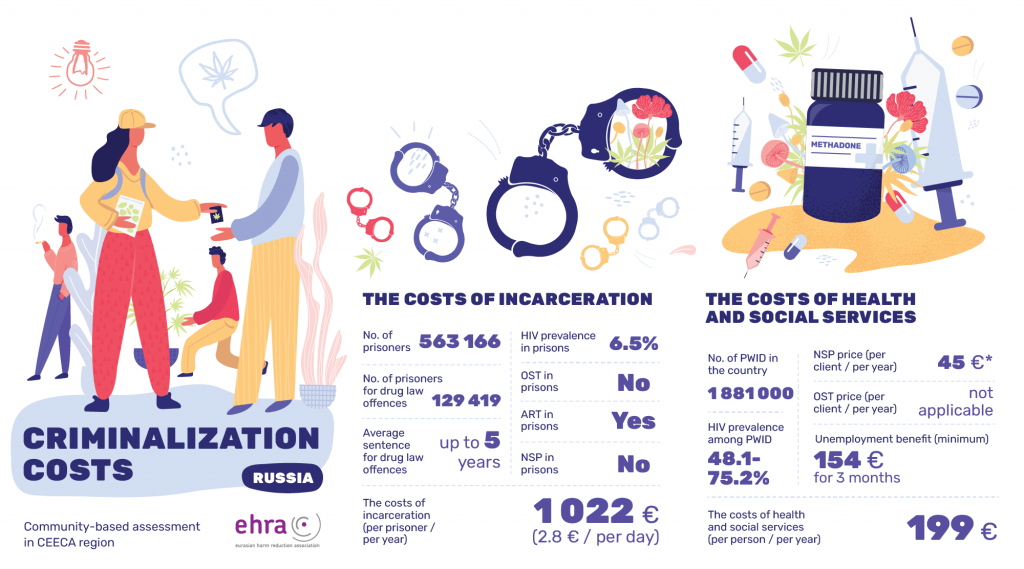There were 563,166 prisoners in the Russian Federation in 2019, of which 129,419 were imprisoned for drug law offences [1]. According to Articles 6.9 and 20.20 of the Code of Administrative Offences, consumption of drugs, or failure to comply with the legal requirement of an authorised official to undergo a medical examination for intoxication, or the consumption of drugs in public spaces, is an administrative offence punishable by a fine of RUB4,000 – RUB5,000 (€55 – €70) or Administrative Detention for up to 15 days. Furthermore, if a person is seen as being drug dependent (in the law it’s written “drug addict”), s/he (with his/her consent) might be sent to a treatment centre, in which case administrative sanctions are not applied; the same applies when a person using drugs voluntarily enrols in treatment services. Under Article 6.8, possession of ‘small amounts’ of drugs is an administrative offence punishable by a fine of RUB4,000 – RUB5,000 (€55 – €70) or Administrative Detention of up to 15 days [2]. Article 228 of the Criminal Code states that possession of a ‘significant amount’ of drugs is punishable with a fine of up to RUB40,000 (€550) or compulsory community service of up to 480 hours, or correctional labour for up to 2 years, or restriction of liberty for up to 3 years, or imprisonment for the same period. Possession of ‘large amounts’ of drugs is punishable through imprisonment from 3 years up to 10 years with a possible fine of RUB500,000 (€7,000) and/or restriction of liberty for up to 1 year. Possession of ‘very large amounts’ of drugs is punishable through imprisonment from 10 years up to 15 years with a possible fine of RUB500,000 (€7,000) and/or restriction of liberty for up to 1.5 years. According to Note 1 to Article 228 of the Criminal Code, a person may be released from criminal liability if s/he voluntarily surrenders the substance and/or cooperates with the investigation (the surrender of substances during arrest or during investigative process after its detection and seizure is not voluntary) [3].
HIV prevalence among prisoners was estimated at 6.5% in 2016 [4] and antiretroviral therapy (ART) is reportedly available in prisons, but not opioid substitution therapy (OST) or needle/syringe programmes (NSP) [5].
Incarceration costs the Government of the Russian Federation €1,022 per inmate, per year, or €2.80 per day [6].
As of 2017, there were estimated to be in the region of 1,881,000 people who inject drugs in the Russian Federation [7]. HIV prevalence estimates vary considerably, with data from 2017 suggesting a prevalence ranging from 48.1% to 75.2% [8] whilst a systematic review of studies published in 2021 suggests a prevalence of 14.3% [9]. The average cost of NSP per client, per year, across the Russian Federation is not known. However, one civil society organisation providing such services estimates the cost to be in the region of €45 per client, per year, although this cost may not be representative across other regions of the country. No OST services exist in community settings, as it is prohibited in Russia. As of 2020, the unemployment benefit was €153.90 per person for a period of 3 months, or €51.30 per month [10].
Whereas it costs, on average, a total of €199 to provide services to people who inject drugs in community settings, the Government of the Russian Federation spends €1,022 to incarcerate each drug user in prison. Consequently, by decriminalising drug use and possession, the Government could save €823 per drug user, per year.
[1] Aebi MF, Tiago MM. SPACE I – 2019 – Council of Europe Annual Penal Statistics: Prison populations. Strasbourg; Council of Europe, 2020. https://wp.unil.ch/space/files/2021/02/200405_FinalReport_SPACE_I_2019.pdf (accessed 4 August 2021).
[2] Government of the Russian Federation. Code Of Administrative Offences Of The Russian Federation No. 195-Fz of December 30, 2001, as amended. Moscow; Government of the Russian Federation, 2 April 2012. https://www.wipo.int/edocs/lexdocs/laws/en/ru/ru073en.pdf (accessed 9 August 2021); see also, Eurasian Harm Reduction Association (EHRA). Penalties for drug law offences in East Europe and Central Asia at a glance. Vilnius; EHRA, 2017. https://old.harmreductioneurasia.org/drug-laws/#Possession (accessed 9 August 2021).
[3] Government of the Russian Federation. The Criminal Code Of The Russian Federation No. 63-Fz Of June 13, 1996, as amended. Moscow; Government of the Russian Federation, 1 March 2012. https://www.wipo.int/edocs/lexdocs/laws/en/ru/ru080en.pdf (accessed 9 August 2021); see also, EHRA, Ibid.
[4] Altice, FL, et al. The perfect storm: incarceration and the high-risk environment perpetuating transmission of HIV, hepatitis C virus, and tuberculosis in Eastern Europe and Central Asia. The Lancet, Sep 17; 388(10050): 1228–1248. https://doi.org/10.1016/S0140-6736(16)30856-X (accessed 9 August 2021).
[5] Harm Reduction International (HRI). Global State of Harm Reduction 2020, Regional Overview 2.2 Eurasia. London; HRI, 2021. https://www.hri.global/files/2020/10/26/Global_State_HRI_2020_2_2_Eurasia_FA_WEB.pdf (accessed 3 August 2021).
[6] Aebi M F, Tiago MM. SPACE I – 2020 – Council of Europe Annual Penal Statistics: Prison populations. Strasbourg; Council of Europe, 2021. https://wp.unil.ch/space/files/2021/04/210330_FinalReport_SPACE_I_2020.pdf (accessed 3 August 2021).
[7] Degenhardt L, Peacock A, Colledge S, Leung J, Grebely J, et al. Global prevalence of injecting drug use and sociodemographic characteristics and prevalence of HIV, HBV, and HCV in people who inject drugs: a multistage systematic review. Lancet Glob Health 2017;5(12):e1192–207. DOI: 10.1016/S2214-109X(17)30375-3 (accessed 10 August 2021).
[8] Plavinsky SL, Ladnaya NN, Barinova AN, Zaitseva EE. Epidemiological surveillance of the second generation for HIV infection. Prevalence of HIV infection and risk behaviour among vulnerable population groups in 7 regions of the Russian Federation, results of bio-behavioural research, 2017. Moscow; Open Institute for Health, 2018. In Russian. http://www.hivrussia.info/wp-content/uploads/2019/05/Biopovedencheskoe-issledovanie-v-7-gorodah-2017.pdf (accessed 10 August 2021).
[9] Davlidova S, Haley-Johnson Z, Nyhan K, Farooq A, Vermund SH, Syed Ali S. Prevalence of HIV, HCV and HBV in Central Asia and the Caucasus: A systematic review. International Journal of Infectious Diseases, Vol. 104, 2021, pp510-525. https://doi.org/10.1016/j.ijid.2020.12.068 (accessed 10 August 2021).
[10] Baklanov A. More than 1.9 million Russians are officially unemployed — here’s how the government plans to help them. Riga; Meduza, 28 May 2020. https://meduza.io/en/feature/2020/05/28/more-than-1-9-million-russians-are-officially-unemployed-here-s-how-the-government-plans-to-help-them (accessed 10 August 2021).

